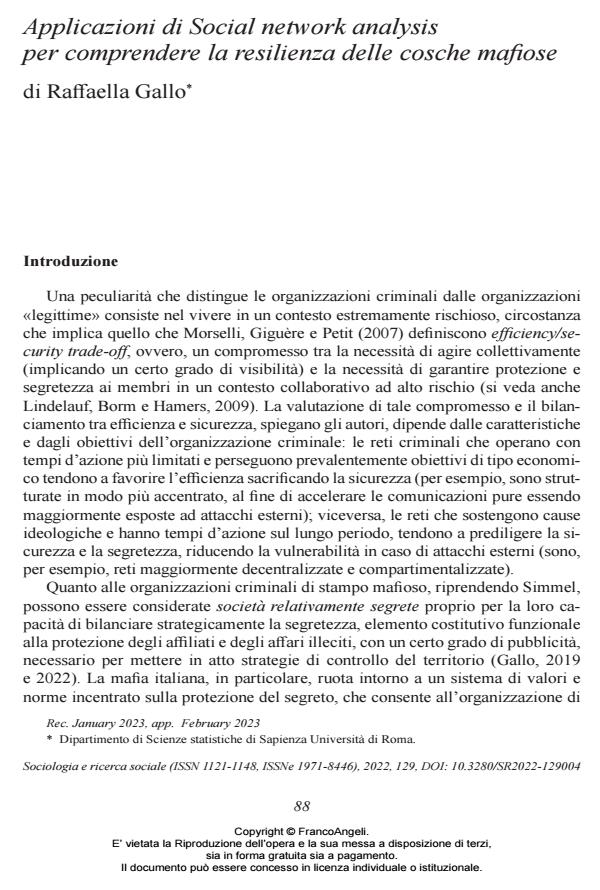Social Network Analysis applications to understand the resilience of mafia gangs
Journal title SOCIOLOGIA E RICERCA SOCIALE
Author/s Raffaella Gallo
Publishing Year 2023 Issue 2022/129
Language Italian Pages 14 P. 88-101 File size 308 KB
DOI 10.3280/SR2022-129004
DOI is like a bar code for intellectual property: to have more infomation
click here
Below, you can see the article first page
If you want to buy this article in PDF format, you can do it, following the instructions to buy download credits

FrancoAngeli is member of Publishers International Linking Association, Inc (PILA), a not-for-profit association which run the CrossRef service enabling links to and from online scholarly content.
With this work we want to is aimed at observing how the priority given to the group over the individual in mafia systems results in the clans’ sectarian structure, generating resilient criminal networks. This will be investigated by comparative analysis of the network of a mafia clan and the network of a non-mafia association. In particular, through different techniques of identification of relevant subjects in the networks, it will «test» the robustness of the two networks, removing those nodes that may represent weak points of the network. The aim is to of demonstrate that more robust networks, such as mafia networks, are configured for a different distribution and characterization of bridge nodes.
- J. Ayling (2009), «Criminal Organizations and resilience», International Journal of Law, Crime and Justice, 37, pp. 187-90.
- S. Borgatti (2006), «Identifying sets of key players in a social network», Comput. Math. Organiz. Theor., 12, pp. 21-34.
- M. Castiello, M. Mosca, S. Villani (2015), «Analisi di resilienza delle reti complesse ed efficacia delle politiche pubbliche di contrasto alla criminalità organizzata», Studi economici, 2, pp. 39-73.
- L. Freeman (1979), «Centrality in social networks: conceptual classification», Social Networks, 1, pp. 215-39.
- R. Gallo (2019), Il ruolo sociologico del segreto, in M. Bonolis, C. Lombardo (a c. di), Ritorno a Simmel. Saggi sull’eredità di un classico, Milano, FrancoAngeli.
- R. Gallo (2020), Per un’analisi delle reti di corruzione: una proposta metodologica, in C. Lombardo (a c. di), Area grigia, scambi illeciti e spazi di potere. Un’analisi delle reti di corruzione, Milano, FrancoAngeli.
- R. Gallo (2022), Relazioni sociali e crimine organizzato. Il caso di una rete ‘ndranghetista, Milano, FrancoAngeli.
- M. Granovetter (1973), «The strength of weak ties», American Journal of Sociology, 78, 6, pp. 1360-80.
- R. Lindelauf, P.E.M. Borm, H.J.M. Hamers (2009), «Understanding Terrorist Network Topologies and Their Resilience Against Disruption», Center Discussion Paper, 85, pp. 1-13.
- C. Lombardo, a cura di (2020), Area grigia, scambi illeciti e spazi di potere. Un’analisi delle reti di corruzione, Milano, FrancoAngeli.
- C. Morselli (2009), Inside criminal networks, New York, Springer Science-Business Media.
- C. Morselli, C. Giguère, K. Petit (2007), «The efficiency/security trade-off in criminal networks», Social Networks, 29, pp. 143-53.
- F. Ozgul, Z. Erdem (2015), Deciding Resilient Criminal Networks, in J. Pej, F.A. Silvestri, J. Tang (eds.), Proceedings of the 2015 Ieee/Acm International Conference on Advances in Social Network Analysis and Mining 2015, New York, Association for Computing Machinery (Acm).
- L. Paoli (2000), Fratelli di mafia. Cosa Nostra e ‘ndrangheta, Bologna, il Mulino.
- R. Sciarrone (2006), «Mafia e potere: processi di legittimazione e costruzione del consenso», Stato e mercato, 78, pp. 369-401.
- G. Simmel (1908), Soziologie. Untersuchungen über die Formen der vergesellschaftung; tr. it. Sociologia, Torino, Edizioni di Comunità, 1998.
- L. Tian, A. Bashan, D. Shi, Y. Liu (2017), «Articulation points in complex networks», Nature Communication, 8, 14223, pp. 1-9.
Raffaella Gallo, Applicazioni di Social network analysis per comprendere la resilienza delle cosche mafiose in "SOCIOLOGIA E RICERCA SOCIALE " 129/2022, pp 88-101, DOI: 10.3280/SR2022-129004